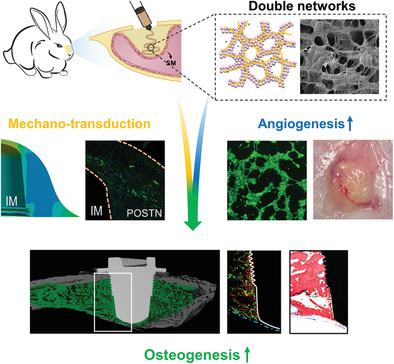当前位置:
X-MOL 学术
›
Adv. Healthcare Mater.
›
论文详情
Our official English website, www.x-mol.net, welcomes your
feedback! (Note: you will need to create a separate account there.)
Gelatin Nanoparticle-Injectable Platelet-Rich Fibrin Double Network Hydrogels with Local Adaptability and Bioactivity for Enhanced Osteogenesis.
Advanced Healthcare Materials ( IF 10.0 ) Pub Date : 2020-01-29 , DOI: 10.1002/adhm.201901469 Zhixiang Mu 1 , Kaiwen Chen 2 , Shuai Yuan 1 , Yihan Li 1 , Yuanding Huang 1 , Chao Wang 1 , Yang Zhang 3 , Wenzhao Liu 1 , Wenping Luo 1 , Panpan Liang 1 , Xiaodong Li 1 , Jinlin Song 1 , Ping Ji 1 , Fang Cheng 4 , Huanan Wang 2 , Tao Chen 1
Advanced Healthcare Materials ( IF 10.0 ) Pub Date : 2020-01-29 , DOI: 10.1002/adhm.201901469 Zhixiang Mu 1 , Kaiwen Chen 2 , Shuai Yuan 1 , Yihan Li 1 , Yuanding Huang 1 , Chao Wang 1 , Yang Zhang 3 , Wenzhao Liu 1 , Wenping Luo 1 , Panpan Liang 1 , Xiaodong Li 1 , Jinlin Song 1 , Ping Ji 1 , Fang Cheng 4 , Huanan Wang 2 , Tao Chen 1
Affiliation

|
Bone healing is a dynamic process regulated by biochemical signals such as chemokines and growth factors, and biophysical signals such as topographical and mechanical features of extracellular matrix or mechanical stimuli. Hereby, a mechanically tough and bioactive hydrogel based on autologous injectable platelet-rich fibrin (iPRF) modified with gelatin nanoparticles (GNPs) is developed. This composite hydrogel demonstrates a double network (DN) mechanism, wherein covalent network of fibrin serves to maintain material integrity, and self-assembled colloidal network of GNPs dissipates force upon loading. A rabbit sinus augmentation model is used to investigate the bioactivity and osteogenesis capacity of the DN hydrogels. The DN hydrogels adapt to the local environmental complexity of bone defects, i.e., accommodate the irregular shape of the defects and withstand the pressure formed in the maxillary sinus during animal's respiration process. The DN hydrogel is also demonstrated to absorb and prolong the release of the bioactive growth factors stemming from iPRF, which could have contributed to the early angiogenesis and osteogenesis observed inside the sinus. This adaptable and bioactive DN hydrogel can achieve enhanced bone regeneration in treating complex bone defects by maintaining long-term bone mass and withstanding the functional mechanical stimuli.
中文翻译:

明胶纳米颗粒可注射的富含血小板的纤维蛋白双网络水凝胶,具有局部适应性和生物活性,可增强成骨作用。
骨愈合是一个动态过程,受生化信号(例如趋化因子和生长因子)和生物物理信号(例如细胞外基质的地形和力学特征或机械刺激)调节。因此,基于明胶纳米粒子(GNP)修饰的自体可注射的富含血小板的纤维蛋白(iPRF),开发了一种具有机械韧性的生物活性水凝胶。这种复合水凝胶展示了双重网络(DN)机制,其中血纤蛋白的共价网络用于维持材料的完整性,而GNP的自组装胶体网络会在加载时消散力。兔鼻窦增大模型用于研究DN水凝胶的生物活性和成骨能力。DN水凝胶适应骨骼缺陷的局部环境复杂性,即 适应缺陷的不规则形状,并承受动物呼吸过程中上颌窦形成的压力。DN水凝胶还被证明可以吸收和延长源自iPRF的生物活性生长因子的释放,这可能有助于在窦内观察到早期的血管生成和成骨作用。这种适应性强且具有生物活性的DN水凝胶可通过维持长期骨骼质量和承受功能性机械刺激来增强骨骼再生能力,从而治疗复杂的骨缺损。这可能有助于鼻窦内观察到的早期血管生成和成骨。这种适应性强且具有生物活性的DN水凝胶可通过维持长期骨骼质量和承受功能性机械刺激来增强骨骼再生能力,从而治疗复杂的骨缺损。这可能有助于鼻窦内观察到的早期血管生成和成骨。这种适应性强且具有生物活性的DN水凝胶可通过维持长期骨骼质量和承受功能性机械刺激来增强骨骼再生能力,从而治疗复杂的骨缺损。
更新日期:2020-03-04
中文翻译:

明胶纳米颗粒可注射的富含血小板的纤维蛋白双网络水凝胶,具有局部适应性和生物活性,可增强成骨作用。
骨愈合是一个动态过程,受生化信号(例如趋化因子和生长因子)和生物物理信号(例如细胞外基质的地形和力学特征或机械刺激)调节。因此,基于明胶纳米粒子(GNP)修饰的自体可注射的富含血小板的纤维蛋白(iPRF),开发了一种具有机械韧性的生物活性水凝胶。这种复合水凝胶展示了双重网络(DN)机制,其中血纤蛋白的共价网络用于维持材料的完整性,而GNP的自组装胶体网络会在加载时消散力。兔鼻窦增大模型用于研究DN水凝胶的生物活性和成骨能力。DN水凝胶适应骨骼缺陷的局部环境复杂性,即 适应缺陷的不规则形状,并承受动物呼吸过程中上颌窦形成的压力。DN水凝胶还被证明可以吸收和延长源自iPRF的生物活性生长因子的释放,这可能有助于在窦内观察到早期的血管生成和成骨作用。这种适应性强且具有生物活性的DN水凝胶可通过维持长期骨骼质量和承受功能性机械刺激来增强骨骼再生能力,从而治疗复杂的骨缺损。这可能有助于鼻窦内观察到的早期血管生成和成骨。这种适应性强且具有生物活性的DN水凝胶可通过维持长期骨骼质量和承受功能性机械刺激来增强骨骼再生能力,从而治疗复杂的骨缺损。这可能有助于鼻窦内观察到的早期血管生成和成骨。这种适应性强且具有生物活性的DN水凝胶可通过维持长期骨骼质量和承受功能性机械刺激来增强骨骼再生能力,从而治疗复杂的骨缺损。











































 京公网安备 11010802027423号
京公网安备 11010802027423号